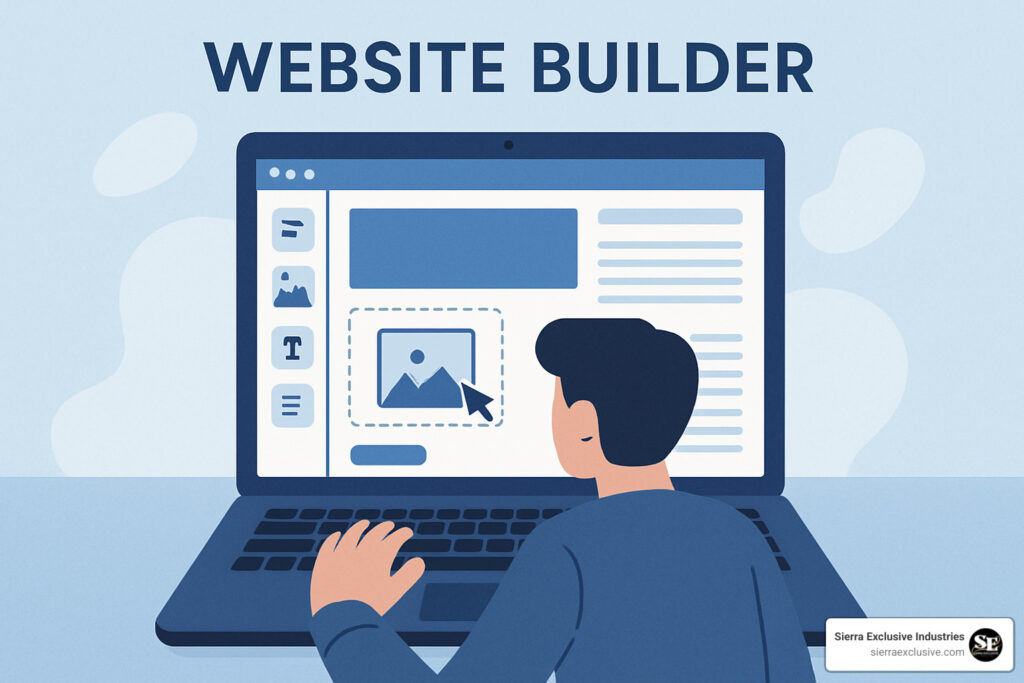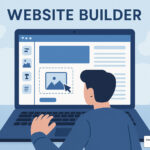Why Website Builders Are Revolutionizing Online Business
A website builder is a drag-and-drop platform that lets you create professional websites without coding. Here’s what you need to know:
Top Website Builder Categories:
- AI-Powered: Describe your business, get instant website
- eCommerce-First: Built for selling online
- Creative/Portfolio: Designer-grade templates
- Enterprise: Team collaboration + advanced features
Key Benefits:
- Launch in minutes to hours (not weeks)
- No coding required
- Built-in hosting, security, and mobile optimization
- Starting costs: Free to $30/month vs $5,000+ custom development
The numbers don’t lie. Modern website builders power millions of sites with hundreds of free templates. The shift is clear – these platforms combine the ease of drag-and-drop with enterprise-grade features like AI content generation, integrated payments, and built-in SEO tools.
Why this matters now: Time-to-market beats perfection. While competitors spend months on custom development, you can test ideas, validate demand, and start generating revenue this week.
You’re not just building a website; you’re launching a complete digital business platform.
I’m Seth Gillen, and I’ve helped scale multiple companies to $10M+ revenue by leveraging the right website builder solutions for rapid market entry. As CEO of Sierra Exclusive Marketing, I’ve seen how the right platform choice can accelerate growth by months or even years.

Why This Guide Matters
When we work with businesses across Sacramento, Roseville, and the greater California region, the most common question isn’t “Should I have a website?” – it’s “How fast can I get online without breaking the bank?”
The website builder landscape has exploded with options, making the choice more critical than ever. You need to understand which platform aligns with your goals, timeline, and technical comfort level. Whether you’re launching a restaurant in Davis, a consulting practice in Folsom, or an e-commerce store in Elk Grove, the right builder can compress months of development into a single afternoon.
Zero-coding solutions have matured to the point where they rival custom development in functionality while maintaining the speed advantage that modern businesses demand. This guide cuts through the marketing noise to show you exactly what each category delivers.
How Modern Website Builders Work & Why They Matter
Remember when building a website meant learning HTML and CSS? Those days are long gone. Today’s website builders work like digital LEGO sets – you simply drag and drop elements where you want them, and the platform handles all the complex coding behind the scenes.
Here’s what happens when you’re designing: As you drag a photo or text block onto your page, the website builder automatically generates clean, professional code. The visual CMS translates your creative vision into responsive HTML and CSS that looks perfect on every device. You’re essentially speaking to the computer in plain English while it does all the technical heavy lifting.
The real breakthrough is AI automation. Modern platforms can create entire websites from a simple conversation. Tell the AI you run a bakery in Sacramento, and within minutes you’ll have a complete site with relevant content, professional images, and proper SEO structure. It’s like having a web developer who works at the speed of thought.
Everything comes bundled together seamlessly. Unlike the old days of juggling separate hosting accounts, domain registrations, and security certificates, today’s builders handle it all in one package. Your site automatically gets enterprise-level security, SSL certificates, and global content delivery networks that make pages load lightning-fast whether visitors are browsing from Roseville or Tokyo.
Performance optimization happens automatically too. The platform compresses images, minimizes code, and sets up caching systems – all the technical stuff that used to require developer expertise. Many builder-created sites actually outperform custom-coded websites because they’re optimized for speed at massive scale.
Every template is mobile-responsive from day one. Your site automatically adapts to smartphones, tablets, and desktops without any extra work from you. This matters more than ever since most people now browse the web on their phones.
For businesses serious about growth, integrating your website builder choice with proven brand awareness strategies creates a powerful foundation for long-term success.

Key Benefits Over Custom Code
The speed difference is dramatic. Custom development typically takes 6-12 weeks minimum – and that’s if everything goes smoothly. With a website builder, you can launch a professional site in hours or days. We’ve watched clients go from idea to live e-commerce store in a single afternoon.
Cost savings are equally impressive. Custom development starts around $5,000 for basic sites and easily hits $20,000+ for e-commerce functionality. Website builders operate on simple monthly subscriptions ranging from free to $50/month. That’s the difference between a major business investment and a monthly coffee budget.
Your site comes SEO-ready right out of the box. The platform automatically generates sitemaps, optimizes loading speeds, and creates proper heading structures that search engines love. Features like automatic alt-text suggestions and meta description templates help your site rank better without requiring any SEO expertise on your part.
Built-in marketing tools eliminate the subscription juggling act. Most platforms include email marketing, social media integration, analytics tracking, and even advertising campaign management. Your website becomes the central hub of your entire digital marketing strategy instead of just one piece of the puzzle.
Collaboration becomes effortless with team-friendly features. Multiple people can update content, manage inventory, or publish blog posts without waiting for developer availability. Role-based permissions ensure everyone has the right level of access without compromising security.
The bottom line? Modern website builders have evolved from simple page creators into complete business platforms that rival custom development in functionality while maintaining the speed and simplicity that growing businesses need.
Website Builder Showdown: 4 Categories You Need to Know

Not all website builders are created equal. Theyve naturally separated into four groups, each optimized for a different goal. Picking the wrong one is like using a sports car to move furnitureit works, but its painful.
AI-Powered Website Builder “Describe & Deploy”
Tell the platform what you do12 lines of textLamazing: youve got a full site. The AI writes starter copy, selects relevant images, and sets up basic SEO. You trade pixel-level control for sheer speed.
eCommerce-Focused Website Builder “Sell in Minutes”
Everythings built around the checkout. Upload products, pick a payment gateway, and start taking orders. Inventory sync, tax, and shipping rules work right out of the box so youre not buried in setup screens.
Creative & Portfolio Builder “Pixel-Perfect Freedom”
Design-first platforms with high-end templates, animation controls, and fine-grained typography. They take longer to learn but let photographers, agencies, and other visual brands stand out without a developer.
Enterprise & Scale-Ready Builder “When Teams Grow”
Think collaboration and compliance: role permissions, staging sites, uptime SLAs, and robust APIs. Perfect when multiple departments need to edit the site without stepping on each other.
| Feature | AI Builder | eCommerce Builder | Creative Builder | Enterprise Builder |
|---|---|---|---|---|
| Setup Time | 515 min | 3060 min | 28 hrs | 13 days |
| Monthly Cost | $1025 | $1540 | $2050 | $50200+ |
| Learning Curve | Minimal | Low | Moderate | High |
| Customization | Limited | Moderate | High | Very High |
| Scalability | SmallMedium | MediumLarge | SmallLarge | Enterprise |
| Best For | Quick launch | Online selling | Visual showcase | Team collaboration |
Choosing the Best Website Builder for Your Needs
Picking the right website builder feels overwhelming when you’re staring at dozens of options. But here’s the thing – the best platform isn’t the one with the most features. It’s the one that matches your specific situation.
Think about it this way: if you’re opening a bakery in Roseville, you don’t need the same tools as a photographer in Davis or a consulting firm in Sacramento. Your goals, timeline, and budget create a unique fingerprint that points to the right solution.
Your primary goal should drive everything else. If you need to start selling products next week, an AI-powered builder gets you online fastest. If you’re building a brand that needs to stand out visually, creative builders give you that pixel-perfect control. If you’re managing a team, enterprise features become essential.
Budget isn’t just about monthly costs either. A “free” platform that takes you 40 hours to figure out might cost more than a paid option you can master in an afternoon. Factor in your time, especially if you’re running a business.
Timeline pressure often makes the decision for you. Got a trade show coming up? Need to launch before your competitor? Sometimes “good enough today” beats “perfect next month.” According to research on CMS market share, the most popular platforms earn their position by being reliable and user-friendly, not necessarily the most feature-rich.
9 Must-Check Features Before You Commit
Before you commit to any website builder, test these nine features. They’ll save you headaches later.
Template quality matters more than quantity. Don’t get distracted by platforms bragging about thousands of templates. Look for 5-10 templates that actually fit your business. A restaurant needs different layouts than a law firm. Quality templates give you a professional starting point instead of a generic one.
Customization depth determines your long-term happiness. Can you easily change colors to match your brand? Swap fonts? Rearrange sections? Some builders let you customize everything, while others lock you into rigid structures. Test the limits before you commit.
SEO tools help people find you. Essential features include custom page titles, meta descriptions, and automatic sitemaps. Without these, you’re building a beautiful website that nobody will find. Advanced platforms add local SEO features – crucial if you serve customers in specific areas like Elk Grove or Folsom.
Mobile preview shows what customers actually see. Over half your visitors will use phones. If your site looks broken on mobile, you’re losing customers before they even read your content. Test your site on actual phones, not just desktop previews.
Domain and hosting integration affects your professional image. Free subdomains scream “amateur.” Custom domains build trust and improve search rankings. Check if domains are included or cost extra.
Security protects your reputation. Automatic SSL certificates, regular backups, and security updates should be standard. A security breach can destroy years of reputation building. Don’t gamble with cheap platforms that skimp on protection.
Marketing tools save money and time. Built-in email marketing, social media scheduling, and analytics eliminate multiple software subscriptions. More importantly, integrated tools share data seamlessly instead of forcing you to manually connect different systems.
Customer support quality becomes critical when problems arise. Test their response time before you need help. Check if they offer phone support, live chat, or just email. Premium plans often include priority support that can save hours of frustration.
Third-party integrations future-proof your choice. Your needs will evolve. Can the platform connect with payment processors, inventory systems, or marketing tools you might need later? Robust app ecosystems prevent you from outgrowing your platform.
Step-by-Step Process to Launch with No Coding
Here’s how to go from idea to live website without writing a single line of code.
Start by planning your pages. Map out what you actually need before you touch any design tools. Most businesses need Home, About, Services, and Contact pages. Local businesses should add location-specific pages mentioning areas like West Sacramento or Citrus Heights for local search benefits.
Pick a template that matches your content style. If you’re showcasing products, choose product-focused layouts. If you’re sharing your story, pick templates with strong About sections. Don’t fall in love with a beautiful template that doesn’t fit your content.
Customize systematically. Start with brand elements like colors and fonts. Then adjust layouts and sections. Finally, add your specific content and images. This order prevents you from redoing work and keeps your design consistent.
Connect your custom domain early. This step often takes time to process, so don’t wait until launch day. A professional domain builds more trust than a free subdomain.
Optimize for search engines before you publish. Add page titles that include your location and services. Write meta descriptions that make people want to click. Add alt-text to images describing what they show. These small steps help people find you later.
Test everything on mobile devices. Use your actual phone to check buttons, forms, and navigation. What looks perfect on your computer might be unusable on a small screen. Fix mobile issues before visitors encounter them.
Prepare for launch day. Double-check contact information, test contact forms, and set up analytics tracking. You want to measure your success from day one, not scramble to add tracking later.
Promote your launch. Share your new site on social media, update your business listings, and tell existing customers. A website doesn’t market itself – you need to drive that initial traffic.
Plan for ongoing improvements. Websites aren’t “set it and forget it” projects. Monitor which pages get the most visitors, gather customer feedback, and update content regularly. Search engines reward active websites with better rankings.
Website Builder vs Headless CMS vs Static Generators
Understanding these three approaches helps you choose the right foundation for your long-term needs.
Website builders bundle everything together – content management, design tools, and hosting in one package. This integrated approach prioritizes simplicity and speed. You can launch professional sites quickly without technical expertise. The trade-off is less flexibility for complex customizations.
Headless CMS separates content management from design, giving developers complete control over the front-end experience. This approach offers maximum flexibility but requires ongoing developer expertise and maintenance. It’s overkill for most small businesses.
Static site generators create lightning-fast websites by pre-building every page as static files. They offer excellent performance and security but require technical knowledge for setup and updates. Content updates become more complex than simple website builders.
For most businesses, especially those serving local markets from Davis to Rocklin, website builders provide the sweet spot of functionality, ease of use, and cost-effectiveness. The integrated approach eliminates technical headaches while delivering professional results.
Consider upgrading to more complex solutions when you need custom functionality, have developer resources available, or require integration with specialized business systems. These solutions become valuable as businesses scale beyond standard website builder capabilities.

Frequently Asked Questions about Website Builders
What types of sites can I create without coding?
Pretty much anything: business brochures, blogs, full e-commerce stores, portfolios, membership areas, and booking systems. If a feature isnt native, most builders have apps or integrations to add it.
How secure are bundled hosting and SSL certificates?
Better than DIY in most cases. SSL is auto-installed, updates roll out platform-wide, and traffic is filtered through enterprise-grade firewalls. Your job: use strong passwords and enable two-factor authentication.
How long does it really take to launch?
Draft site: minutes with AI. Polished, client-ready version: 24 hours if your content is prepared. Endless tweaking can stretch the timeline, but most businesses can go live inside a week when they focus on “good enough” first.
Conclusion
The website builder revolution has fundamentally changed how businesses approach their online presence. What once required months of development and thousands of dollars can now happen in an afternoon with a modest monthly investment.

The data tells a compelling story. Traditional web development takes 6-12 weeks and costs $5,000-$20,000 for basic functionality. Modern website builders compress this timeline to hours or days while reducing costs by 95%. That’s not just incremental improvement – it’s a complete change of what’s possible for small and medium businesses.
The choice between categories becomes clearer when you focus on your primary objective. AI-powered builders excel when speed trumps customization. Simply describe your Sacramento consulting practice or Roseville retail store, and within minutes you have a professional foundation ready for fine-tuning.
E-commerce focused platforms shine when selling is your priority. The integrated approach to inventory management, payment processing, and shipping calculations eliminates the headaches that traditionally made online selling complex and expensive.
Creative and portfolio builders reward the time investment with pixel-perfect control over your brand presentation. For businesses where visual impact drives customer decisions, this category delivers results that rival custom development.
Enterprise solutions provide the collaboration tools and scalability that growing teams need. While they require larger investments in both time and budget, they eliminate the painful migrations that happen when businesses outgrow simpler platforms.
The most successful businesses we work with across Northern California share one common trait: they prioritize launching over perfecting. A live website generating leads and sales beats a perfect website still in development every single time.
Your path forward is straightforward. Identify your primary goal – whether that’s establishing credibility, showcasing work, or selling products. Choose the appropriate category based on your timeline and technical comfort level. Start building today rather than waiting for the perfect moment or perfect plan.
The businesses thriving in today’s market understand that digital presence isn’t optional – it’s the foundation of modern customer acquisition. The website builder category you choose matters less than choosing one and getting started.
Ready to accelerate your digital growth? Our comprehensive web design services combine strategic planning with the right platform selection to maximize your online impact and business results.






